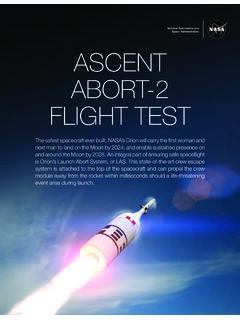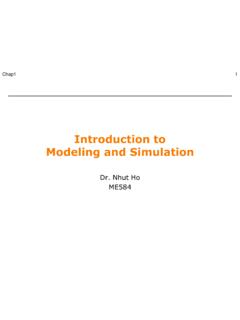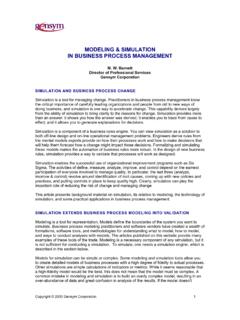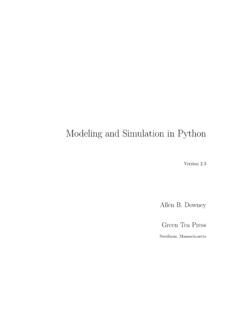Transcription of Modeling, SiMulation, inforMation technology & …
1 National Aeronautics and Space AdministrationApril 2012 modeling , simulation , inforMation technology & ProceSSing roadMaPTechnology Area 11 Mike Shafto, ChairMike ConroyRich DoyleEd GlaessgenChris KempJacqueline LeMoigneL u i Wa n gThis page is intentionally left blankTable of ContentsForeword Executive Summary TA11-11. General Overview Technical Approach Benefits Applicability/Traceability to NASA Strategic Goals Top Technical Challenges TA11-52. Detailed Portfolio Discussion Summary description and Technical Area Breakdown Structure (TABS) Description of each column in the TABS Computing Flight Computing Ground Computing modeling Software modeling and Model-Checking Integrated Hardware and Software modeling Human-System Performance modeling Science and Aerospace Engineering modeling Frameworks, Languages, Tools, and Standards simulation Distributed simulation Integrated System Lifecycle simulation simulation -Based Systems Engineering simulation -Based Training and Decision Support inforMation Processing Science, Engineering.
2 And Mission Data Lifecycle Intelligent Data Understanding Semantic Technologies Collaborative Science and Engineering Advanced Mission Systems TA11-223. Interdependency with Other technology Areas TA11-254. Possible Benefits to Other National Needs TA11-255. National Research Council Reports NRC Recommended Revisions to the TABS NRC Prioritization Additional / Salient Comments from the NRC Reports TA11-26 Acronyms TA11-32 Acknowledgements TA11-33 References TA11-33 ForewordNASA s integrated technology roadmap, including both technology pull and technology push strategies, considers a wide range of pathways to advance the nation s current capabilities. The present state of this effort is documented in NASA s DRAFT Space technology Roadmap, an integrated set of fourteen technology area roadmaps, recommending the overall technology investment strategy and prioritization of NASA s space technology activities.
3 This document presents the DRAFT technology Area 11 input: modeling , simulation , inforMation technology & Processing. NASA developed this DRAFT Space technology Roadmap for use by the National Research Council (NRC) as an initial point of departure. Through an open process of community engagement, the NRC will gather input, integrate it within the Space technology Roadmap and provide NASA with recommendations on potential future technology investments. Because it is difficult to predict the wide range of future advances possible in these areas, NASA plans updates to its integrated technology roadmap on a regular SummaryFigure 1 is an initial draft strategic roadmap for the modeling , simulation , inforMation Technol-ogy and Processing technology Area.
4 Although highly notional, it gives some idea of how the de-velopments in Computing, modeling , simulation , and inforMation Processing might evolve over the next 10-20 years. In spite of the breadth and di-versity of the topic, a small number of recurring themes unifies the requirements of aerospace engi-neering, remote science, current space operations, and future human exploration missions. There is a surprising consensus regarding the research need-ed to realize the benefits of simulation -based sci-ence and engineering, and of emerging paradigms in inforMation our purposes, Computing covers innovative approaches to flight and ground computing that have the potential to increase the robustness of fu-ture aerospace systems and the science return on long-duration exploration missions.
5 Flight Com-puting requires ultra-reliable, radiation-hardened platforms which, until recently, have been cost-ly and limited in performance. Ground Com-puting requires supercomputing or other high-performance platforms to support petabyte-scale data analysis and multi-scale physical simulations of systems and vehicles in unique space environ-ments. In both multi-core flight computing and high-end ground computing, performance is con-strained by complex dependencies among hard-ware, algorithms, and problem structure. We assume that fundamental advances in the Com-puting area will benefit modeling , simulation , and inforMation , simulation and decision making are closely coupled and have become core technolo-gies in science and engineering.
6 In the simplest sense, a model represents the characteristics of something, while a simulation represents its be-havior. Through the combination of the two, we can make better decisions and communicate those decisions early enough in the design and develop-ment process that changes are easy and quick, as opposed to during production when they are ex-tremely costly and practically impossible. modeling covers several approaches to the inte-gration of heterogeneous models to meet challeng-es ranging from Earth-systems and Heliophysics modeling to autonomous aerospace vehicles. The main topics of this section are Software Model-ing, Integrated Hardware and Software Mod-eling, and large-scale, high-fidelity Science and Aerospace Engineering modeling , for example, Earth-system (climate and weather) modeling or modeling the performance of an autonomous Eu-ropa lander.
7 simulation focuses on the architectural chal-lenges of NASA s distributed, heterogeneous, and long-lived mission systems. simulation represents behavior. It allows us to better understand how things work on their own and together. Simula-tion allows us to see and understand how systems might behave very early in their lifecycle, without the risk or expense of actually having to build the system and transport it to the relevant environ-ment. It also allows us to examine existing large, complex, expensive or dangerous systems without the need to have the physical system in our posses-sion. This is especially attractive when the system in question is on orbit, or on another planet and impossible to see or share with others; or when the system does not yet exist, as in the case of ad-vanced autonomous Processing includes the system-level technologies needed to enable large-scale re-mote science missions, automated and reconfig-urable exploration systems, and long-duration human exploration missions.
8 Given its scope, po-tential impact, and broad set of implementation issues, simulation provides many of the challenges faced in advanced inforMation processing systems. There are software engineering challenges related to simulation reuse, composition, testing, and hu-man interaction. There are systems questions re-lated to innovative computing platforms. There are graphics and HCI questions related to the in-terface with users of varying disciplines and levels of expertise. In NASA s science and engineering domains, data-analysis, modeling , and simulation requirements quickly saturate the best available COTS or special-purpose platforms. Multi-res-olution, multi-physics, adaptive and hybrid sys-tems modeling raise challenges even for theoret-ical computer science.
9 At the most practical level, separation of concerns becomes critical when sys-tems and services are no longer locally provisioned and coupled to local implementations. For exam-ple, systems that decouple storage and data pro-cessing, as well as data storage and data manage-ment, are more likely to take early advantage of elastic technology paradigms like cloud: There is more opportunity to leverage the lowest common denominator services that cloud provides, such as compute and store, without navigating other large complex subsystems independent of pay-for-play cloud General overviewA mission team s ability to plan, act, react and generally accomplish science and exploration ob-jectives resides partly in the minds and skills of engineers, crew, and operators, and partly in the flight and ground software and computing plat-forms that realize the vision and intent of those engineers, crew and to NASA missions increasingly con-cern operating in remote and imperfectly under-stood environments.
10 And ensuring crew safety in the context of unprecedented human spaceflight mission concepts. Success turns on being able to predict the fine details of the remote environment, possibly including interactions among humans and robots. A project team needs to have thought through carefully what may go wrong, and have a contingency plan ready to go, or a generalized re-sponse that will secure the crew, spacecraft, and against these engineering realities are always-advancing science and exploration objec-tives, as each mission returns exciting new results and discoveries, leading naturally to new science and exploration questions that in turn demand greater capabilities from future crew, spacecraft and healthy tension between engineering and system designs on the one hand.



















